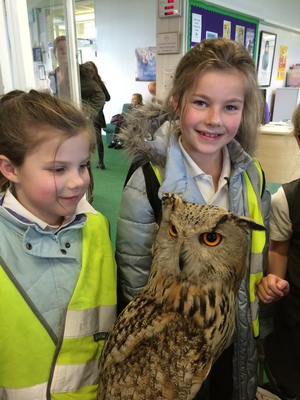
Boris and Henry Meet Year 5
Published on 2015-03-10 by Gill Hickman
When Henry the Harris Hawk and Boris the Siberian Eagle Owl visited Year 5 children of Orchard Junior School with their owner Paul, the children were in for a treat. Having recently studied classification, their talk began with an introduction to the word ‘raptor’ and several impressive students were able to identify the five groups of raptors as eagles, hawks, falcons, owls, and vultures as raptors, or birds of prey. Paul pointed out the specific anatomical features that qualified Henry and Boris as raptors: strong grasping feet equipped with sharp talons, a hooked upper beak, and excellent binocular vision.
Children learnt that Harris Hawks are social birds that piggy back on each other and hunt in groups and can even predate on rattlesnakes. Henry displayed his particularly long legs at this point. Some children also learnt about imprinting and that Henry, a young Harris Hawk, had slightly imprinted himself on his ‘Dad’, Paul!
Paul explained why Boris, the Siberian Eagle Owl, was capable of silent flight. Children noticed his impressively large orange eyes and loved their colour. Several were fascinated by his occasional blinking! They learnt that eye colour seems to be an indicator of when the owls prefer to hunt, whether it's at night, during the day or in the soft light of dawn and dusk. Regardless of eye color, owls tend to have excellent eyesight and the ability to see in the dark. Three year five children already knew what orange eyes like those of the Siberian Eagle Owl meant – that they are active and hunt at dawn and dusk. They heard that yellow eyes often appear on owls that are diurnal -- they prefer to hunt during the day and that owls that have dark brown or black eyes typically are nocturnal, which means they prefer to hunt at night. The barn owl was cited as an example. Impressively this owl can hunt in pitch black using their hearing to help.
Most children thought Boris’ tufts on his head were ears, but they quickly learnt that this is not so and that his ears are holes on the side of his head – one slightly lower than the other to allow the owl to pinpoint the exact position of its prey.
The children than saw owl pellets and Paul explained why and how they are formed. Next week’s treat for the children is for them to dissect the pellets to discover what the owl has eaten.
Finally children were given an amazing opportunity. This captive-bred owl is good tempered and very tolerant of people, unlike Henry the Harris hawk! Not just could children get up close to the owl but they were allowed to gently touch him as they moved out of the room. A truly unforgettable experience for many students who returned for second helpings at the end of school!
